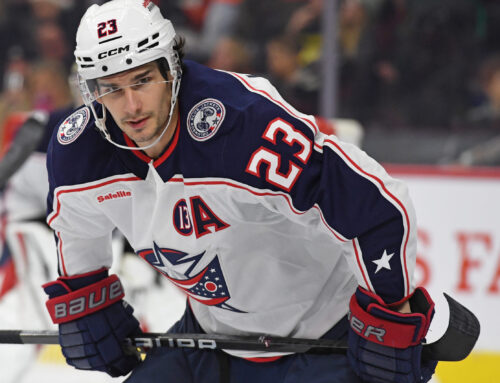
Another great feature of Dobber’s Frozen Tools is the Shots tab and the breakdown it provides for shots from various distances, shots attempted, shots on goal, EV SOG, PP SOG, and SH SOG.
I thought it would be interesting to go back over four seasons of data and see if there were forwards who thrived at certain distances and what players paid the price to get the shots from in close the most. Is there a pattern that emerges for older or younger players as they develop or decline with their goal production?
We will start with the top ten forwards in 2015-2016 for shots from zero to 15 feet away and see how they have fared in the years till now:
All information is from Dobber’s Frozen Tools Report Generator.

Boone Jenner led forwards with 103 shots from zero to 15 feet (SOG 0-15), and had 30 goals that year while boasting a 13.3 shooting percentage on 225 SOG on 344 SAT (shot attempts) at the age of 22. If we look at the four seasons from 2015-2016 to 2018-2019, we can see a pattern emerging as to why Jenner’s goal totals have gone down along with his shooting percentage.

Even though his TOI was higher in 2018-2019 than it had been in prior years and he is still on the PP, his PP SOG have decreased from 47 to 13, and his SOG 0-15 have decreased from 103 to 41. He had nine PP goals in his one 30-goal year and is now lucky to see one or two. He’s not nearly as effective when he’s not shooting from in close when given PP time. Jenner is just an example of how difficult it is to predict what will happen, as looking at his 22-year-old season, he had just scored 30 goals and seemed to be trending up. It’s amazing that something as simple as his deployment on the PP could have such an effect on his future production.
Wayne Simmonds’s production fell off considerably last season, split between Philadelphia and Nashville, and he is hoping to rebound. Let’s look at his shot numbers since 2015-2016.

Simmonds is still generating chances in close and his shooting percentage has stayed relatively consistent, but he has declined considerably in EV SOG and shots from over 15 feet. This tells us that he is not generating anything off the rush anymore and is solely reliant on shots from in close. He will struggle to get back above 20 goals.
Jamie Benn is another player who had a down year that we can take a closer look at.

Benn has never been a huge shooter, but has always had a fairly high shooting percentage. Looking at his shot data, his attempts are down and mostly in the SOG 16-30 range; much like Simmonds, perhaps, his off-the-rush opportunities are declining. Having said that, he had a 36-goal year in 2017-2018 after a down year as well, and if anyone can bounce back it will be him—but a rebound will be in the 28-32 goal range.
Tomas Hertl had a breakout season last year with 35 goals and 74 points. Were there some signs in his shot data projecting an uptick in goal production? Not really

His PP shots increased slightly but not from his 22-goal year in 2017-2018. The only big difference for Hertl is a very high shooting percentage of 19.9, and that is going to be hard to duplicate. He will have a tough time scoring 30 goals again and will probably be in the 25-goal range.
John Tavares had his best goal production in 2018-2019 with 47 goals. He was obviously surrounded by some pretty good players but his PP production was not any greater than in his prior years.

Tavares increased his EV SOG as well as his SOG 0-15, creating more SAT and matching his career high of 286 SOG. It is easier to maintain a higher shooting percentage when over 42 percent of your shots are from in close (especially with Tavares’s skill). If he plays 75 games or more, I think he’s a given for 40 goals.
Last on our list this week is Jeff Skinner, who had 40 goals in his first season in Buffalo. He shoots the puck a lot and had a shooting percentage of 14.9 last year.
I’m not as doubtful about Skinner duplicating 40 goals as I was a few months back (it is still unlikely). He obviously made some adjustments on where he was shooting the puck from, as evidenced by his large increase in SOG 16-30 and decrease in SOG 31-45. He lowered his SAT but still maintained his SOG in comparison to prior years, and this indicates that he was a little more selective in his attempts. I still don’t think he will maintain his shooting percentage from last season, so I will guestimate his goal total around 35 next season.
There is so much information in these reports and I’m genuinely curious about how other players like Connor McDavid, Nathan Mackinnon and Auston Matthews distribute their shots and how it might change from year to year. Maybe, we will expand this topic into another short series?
Thanks for reading and please follow me on Twitter @gampbler15.





 FLA
FLA CHI
CHI NYR
NYR PIT
PIT L.A
L.A COL
COL CAR
CAR VGK
VGK MIN
MIN N.J
N.J CBJ
CBJ BOS
BOS
 T.B
T.B
